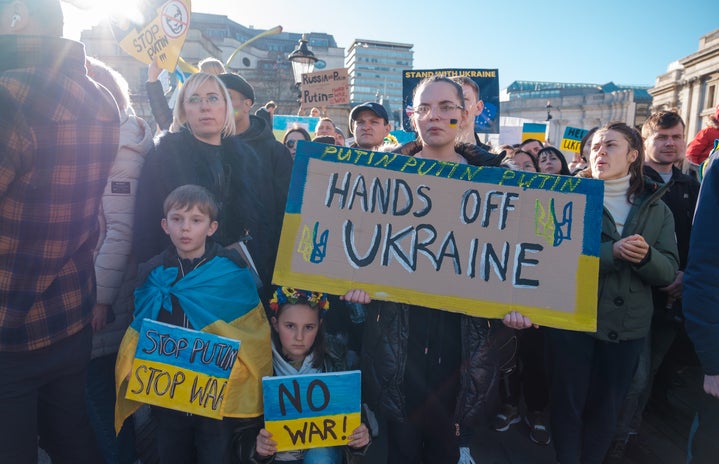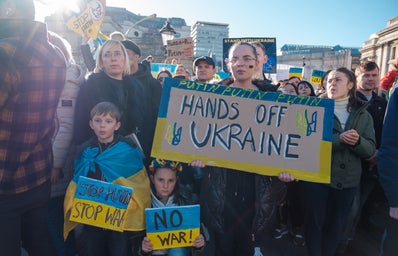This week, Georgia delves deep into the recent invasion of Ukraine by Putin and Russain forces, detailing brief historical background leading up to this catastrophic event.
On the 24th of February President Putin televised an announcement which began a military operation in Ukraine. Russian troops subsequently crossed the border and targeted cities and airports by plane and missile launcher. It since seems as though the world has erupted into chaos, with constant media coverage and fears over the implications as well as extent of this invasion.
Multiple countries, including that of the UK, US and many within the EU, have since placed sanctions intended to strain the Russian economy, with hopes of stopping further devastation.
But how exactly did this happen?
Though to many, especially those who aren’t constantly up to date with global affairs, this may appear like a sudden escalation, and it certainly wasn’t entirely expected given the global response. However, Ukraine and Russia have had a historically turbulent relationship leading up to this point. Consequently, to this day, many Russians still believe the Ukrainian capital, Kyiv, to be the birthplace of their nation. Putin himself declared that “Russians and Ukrainians are one people- a single whole.”
Ukraine and Russia’s relationship began more than a thousand years ago. Both countries were once part of Kyvivan Rus, the first East Slavic state. This largely remained the case until the Mongols conquered the region in the thirteenth century. Since then, a period of invasions and division began. Polish and Lithuanian armies invaded in the sixteenth century and in the seventeenth century, a war between the Polish-Lithuanian Commonwealth and the Tsardom of Russia took place.
For a significant period of Ukraine’s history, it was under Russian rule. Eastern Ukraine came under Russian at first, with Western Ukraine being ruled by Poland. The West, however, was eventually annexed by the Russian Empire in 1973. During imperial rule, the policy of Russification had great implications. The use and study of the Ukrainian language was banned, and people were pressured to convert to Russian Orthodox. Russia’s political stage underwent much change, with the occurrence of the 1917 communist revolution and civil war.
This led Ukraine to be fully absorbed into the Soviet Union in 1922.
Under the Soviet Union, Stalin’s policy of collectivisation, led to great famines that largely affected ethic Ukrainians, killing millions. It wasn’t until 1991 that, with the collapse of the Soviet Union, Ukraine was declared an independent state.
However, uniting Ukraine was not an easy task. Ukraine had lasting divisions between the Eastern and Western sides. Due to Eastern Ukraine having been absorbed into Russian rule much earlier, it tended to be the case that people in the Eastern side felt stronger ties to Russia than those in the West. It was also the case that the population of the East tended to speak Russian and hold Orthodox beliefs, while those in the West were more likely to speak Ukrainian and practice Catholicism .This led to contrasting feelings towards nationalism versus sympathies towards the nostalgia of imperial Russia.
These clashes carried on into the twenty-first century.
The efforts of both the 2004 Orange Revolution, when thousands mobilised in favour of free and fair elections, and the 2014 Euromaidan protests culminated in the overthrow of President Viktor Yanukovych, who appeared friendly to Russian interests and who refused to sign a trade agreement with the EU. This became known as the Revolution of Dignity. The following interim government then signed a trade agreement with the EU, seen as a step towards EU membership.
However, these revolts sparked pro-Russian separatists to protest and declare independence in the eastern region of the Donbas. This led to armed conflict and eventual Russian involvement. Whilst the war in Donbas spread West, April of that year saw a pivotal turning point when Russia invaded and annexed the Ukrainian peninsula of Crimea. In 2014 and 2015, Russia, Ukraine, France and Germany all sign a series of cease-fire agreements. However, hostilities remained, with Ukraine electing Volodymr Zelensky as president in 2019 who promised to restore Donbas to the country.
An issue of contention that remains is membership of NATO, an international military alliance established after the Second World War, of which neither Russia nor Ukraine is a part of. Ukraine, however, appealed to Biden in early 2021 to once again consider membership. Putin, on the other hand, demanded security assurances including that NATO pull back troops from surrounding regions and that Ukraine should never join the organisation. Coinciding with these demands, Russia began to organise troops near Ukraine’s border but claimed to be doing training exercises, with an estimate of over 100,000 troops by November 2021.
From then on, tensions grew, with the US sending extra troops to Poland and Romania and other NATO members warning sanctions, leading to the eventual invasion and the continuation of a tumultuous history.


